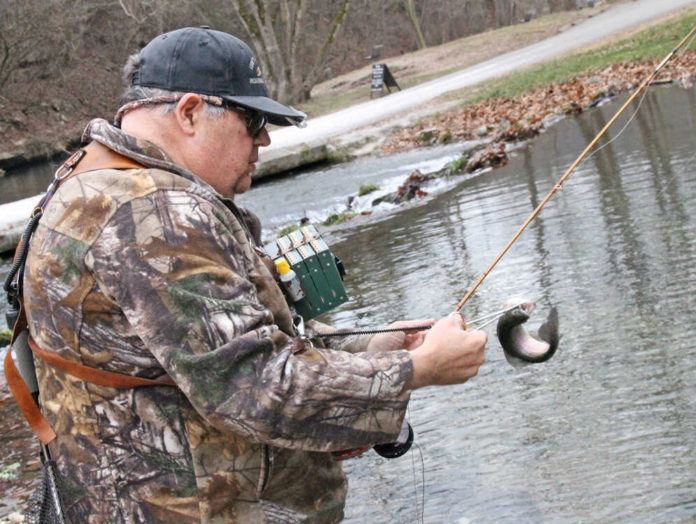Tim Homesley, owner of Tims Fly Shop, releases a trout he caught while fly fishing recently at Roaring River State Park. Kyle Troutman/editor@monett-times.com
Local angler gives tips for Roaring River fishing
When it comes to fishing for trout at Roaring River State Park, not many can say they do it as often or as well as Tim Homesley.
For about 50 years, Homesley, owner of Tims Fly Shop just north of the river, has been pulling out trout by the thousands, and he enjoys offering tips to anglers hoping to make the best of their fishing trips to the crystal clear waters of Roaring River.
Tim Homesley, owner of Tims Fly Shop, reels in a trout while fly fishing at Roaring River State Park. Homesley offers tips to anglers in the area for making sure they enjoy their fishing trips. Kyle Troutman/editor@monett-times.com
I try to fish at least a couple of days per week, on Mondays and Fridays, during the off-season, Homesley said. I probably fish even more during the on-season just because Im down here more.
Homesley is a master of the fly rod, and the array of baits he uses to catch trout run the gamut.
Right now, if youre using a fly rod, an orange mop fly or a cream mega worm will catch anything at any time, he said. If you fish traditionally, pheasant-tail nymphs will catch fish all year long. This specific time of year, if you like dry flies, elk hair caddis are good to use because they are hatching [in the wild].
A trout at Roaring River State Park fights its bite. There are numerous ways to fish during the catch-and-release season, and Tim Homesley, owner of Tims Fly Shop, hopes to help anglers make the best of their experiences. Kyle Troutman/editor@monett-times.com
Homesley said dry flies can be tailored more to the seasons of the year and what is organically hatching near the river, but some things are sure-fire standbys.
Nymphs dont change a whole lot, he said. One thing anyone can throw is what we call a tractor pattern, because its bright and catches the fishes attention. Some people will even throw three or four flies on the same line, using a brighter fly at the bottom to attract a fish, which eventually hits on the less bright fly further up.
When March rolls around, Homesley said switching to wooly buggers is the way to go.
I usually start the day with black or olive wooly buggers, then if I go back in the afternoon, Ill use San Juan worms or an egg pattern, Homesley said. I prefer to sight-fish, where you can actually see them strike the bait.
Using an indicator is a productive way to catch fish, but it gives them an extra half second to shake it or move on. When you sight-fish, you can pull the rod right as the fish strikes.
Technique for making the catch is one thing, but what can anglers do if the fish plain ignore them? Homesley has a solution for that, too.
Some days, they can be picky, he said. Fridays are usually the easiest, then Saturdays and Sundays get tougher, and by Mondays, it can be a challenge at times. The water really controls most of it, but cream mega worms, white shammy, pheasant tail or egg patterns almost always work. A lot of times, trout will take stuff they never actually eat, but they have to test it to see if its food.
Homesley said there is one big mistake anglers tend to make, and its a simple one.
The worst thing you can do is to stay in one spot, he said. You have to move around a lot. If youre in a place and dont get a hit for 10 minutes, go somewhere else down the stream. You can always go back later and see if they are hungrier. Another thing is if youre catching some and they stop hitting, switch up flies and throw something else at them.
Another thing Homesley stresses is a baits durability.
Some flies tied with cotton or other material can come undone when it gets wet, and fish wont even go for it, he said. One fly can usually bring you about 10-12 fish, but I had one San Juan that I caught 42 fish with, so a durable fly is big. Most people end up tearing up their flies themselves, doing things like twisting it with forceps.
Homesley said no specific bait attracts a specific size, and bigger fish are just as gullible as the little guys.
When they first hit the water, those big ones will hit anything, he said. But once they are in there a while, they start to get more picky, browns especially. once they get to about 18 inches, they will start to stay deep and in the shade. Those ones can get hard to catch. Rainbows typically dont have that wild instinct, partially because they are hatched and domesticated.
Homesley said the history of fishing, especially with flies, is storied in the Roaring River area and across Missouri.
There is a guy named Ed Story from St. Louis that put out a paperback book I still refer to once in a while, Homesley said. He really popularized the crackleback in Missouri and has several other go-to patterns. We tie flies a little different around here, but similar to how its done across the rest of the country.
Homesley is working on being more informative about Roaring River conditions and fishing outlooks. He is planning to start a weekly report on his Tims Fly Shop page on Facebook.
Credit: Source link































